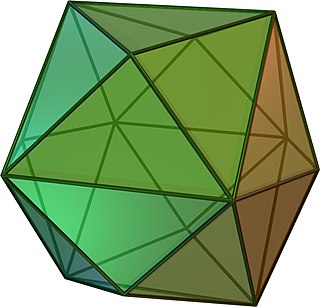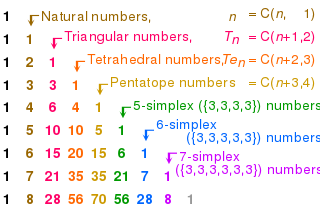
In geometry, an octahedron is a polyhedron with eight faces. The term is most commonly used to refer to the regular octahedron, a Platonic solid composed of eight equilateral triangles, four of which meet at each vertex.

The Sierpiński triangle, also called the Sierpiński gasket or Sierpiński sieve, is a fractal attractive fixed set with the overall shape of an equilateral triangle, subdivided recursively into smaller equilateral triangles. Originally constructed as a curve, this is one of the basic examples of self-similar sets—that is, it is a mathematically generated pattern that is reproducible at any magnification or reduction. It is named after the Polish mathematician Wacław Sierpiński, but appeared as a decorative pattern many centuries before the work of Sierpiński.
In mathematics, Pascal's triangle is a triangular array of the binomial coefficients which play a crucial role in probability theory, combinatorics, and algebra. In much of the Western world, it is named after the French mathematician Blaise Pascal, although other mathematicians studied it centuries before him in Persia, India, China, Germany, and Italy.
2 (two) is a number, numeral and digit. It is the natural number following 1 and preceding 3. It is the smallest and only even prime number.
10 (ten) is the even natural number following 9 and preceding 11. Ten is the base of the decimal numeral system, the most common system of denoting numbers in both spoken and written language.
20 is the natural number following 19 and preceding 21.

In mathematics, a square triangular number is a number which is both a triangular number and a square number. There are infinitely many square triangular numbers; the first few are:
1000 or one thousand is the natural number following 999 and preceding 1001. In most English-speaking countries, it can be written with or without a comma or sometimes a period separating the thousands digit: 1,000.
300 is the natural number following 299 and preceding 301.
400 is the natural number following 399 and preceding 401.
500 is the natural number following 499 and preceding 501.
One half is the irreducible fraction resulting from dividing one (1) by two (2), or the fraction resulting from dividing any number by its double.
700 is the natural number following 699 and preceding 701.
126 is the natural number following 125 and preceding 127.

In geometry, a tetrakis hexahedron is a Catalan solid. Its dual is the truncated octahedron, an Archimedean solid.

In number theory, a pentatope number is a number in the fifth cell of any row of Pascal's triangle starting with the 5-term row 1 4 6 4 1, either from left to right or from right to left. It is named because it represents the number of 3-dimensional unit spheres which can be packed into a pentatope of increasing side lengths.
Lucas pseudoprimes and Fibonacci pseudoprimes are composite integers that pass certain tests which all primes and very few composite numbers pass: in this case, criteria relative to some Lucas sequence.

The lazy caterer's sequence, more formally known as the central polygonal numbers, describes the maximum number of pieces of a disk that can be made with a given number of straight cuts. For example, three cuts across a pancake will produce six pieces if the cuts all meet at a common point inside the circle, but up to seven if they do not. This problem can be formalized mathematically as one of counting the cells in an arrangement of lines; for generalizations to higher dimensions, see arrangement of hyperplanes.

5 (five) is a number, numeral and digit. It is the natural number, and cardinal number, following 4 and preceding 6, and is a prime number.

Bernoulli's triangle is an array of partial sums of the binomial coefficients. For any non-negative integer n and for any integer k included between 0 and n, the component in row n and column k is given by:












